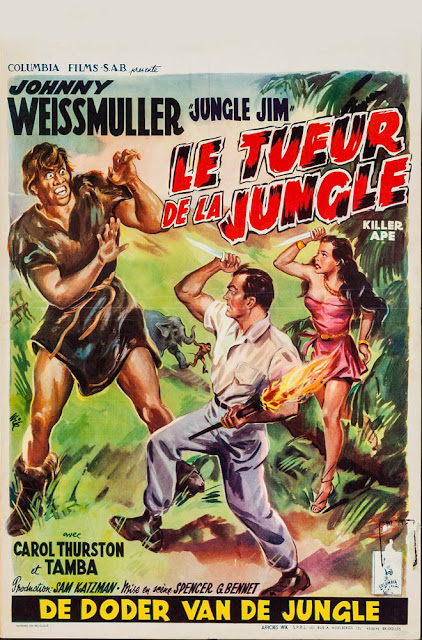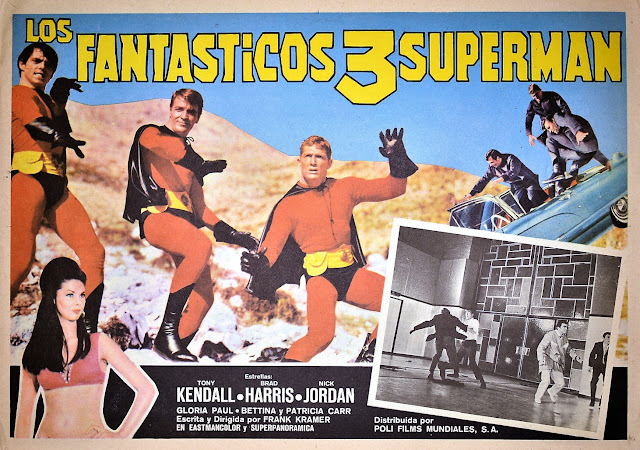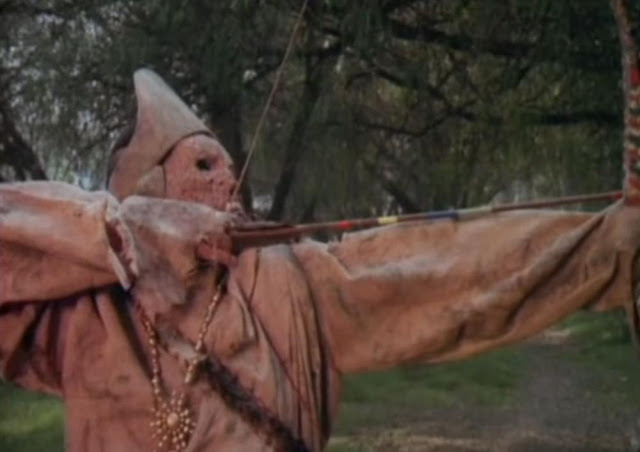PHENOMENALITY: *marvelous*
MYTHICITY: *good*
FRYEAN MYTHOS: *drama*
CAMPBELLIAN FUNCTION: *metaphysical*
I doubt that anyone ever interviewed female exploitation filmmaker Brianne Murphy, given that most of her work was in cinematography and her one theatrical movie, BLOOD SABBATH, barely got a decent release. But I like to think that if anyone had asked her for a rationale as to why a woman director would make a "sex witch" film in which roughly half a dozen young women put their goods on display for male objectification, I like to think she'd have said, "The better to empower women by showing their total ability to destroy men."
The film opens as spacey-looking Vietnam vet David (Tony Geary) wanders along a country road in what's supposed to be Mexico. A van drives up, and a half-naked girl (Uschi Digard) offers him a beer, only to spray it all over him before the van drives off. The arbitrary meanness of the van-people serves to mark David as a patsy for future female domination. Night falls as David makes a campfire and goes to sleep with his shirt off. Three naked women-- presumably part of the witch-cult we see later-- swarm over him to "have some fun." David is shocked rather than pleased by their forceful attentions-- maybe too much like an attack for his taste?-- and runs off. The three girls chase him for a while, suggesting that they'd be just as happy with non-consensual as consensual sex.
David takes a fall and knocks himself out, so his pursuers leave him alone, apparently not willing to do it with a possible corpse. He dreams that he meets a white-clad woman named Yyala (Susan Damante), and he's immediately taken with her, asking her to meet him again before she disappears into the waters. Then the fellow wakes up and meets a forest hermit named Lonzo, who tells him he ought to stay away from the lake. ("This place means only loneliness," says Lonzo.) Lonzo offers to take David to the nearby village before he gets moving on down the road.
David, whose internal dialogue suggests some PTSD from Vietnam, doesn't go to the village, but shows up at the lake at the appointed time, and Yyala is indeed waiting for him, leading to this trippy exchange.
"You are real."
"Do you think I am?"
"I want you to be."
"Then I am."
David becomes totally enthralled with Yyala, but she tells him she's a soulless creature of the waters and cannot love a mortal man, possessed as he is of a soul. (Writer William Bairn was perhaps trying a little inversion on Anderson's "Little Mermaid.")
While this assignation goes on, we meet the ruler of the witch-cult, the risibly named Alotta (Dyanne Thorne), first seen approaching Lonzo at his humble hut. When Alotta shows interest in the newcomer, Lonzo tells her that she's overstepping the bounds of their agreement, which includes Lonzo providing the witch-queen with children-- though it's not specified what Lonzo gets out of the arrangement. The viewer may assume that child sacrifice is involved, though a later exchange claims that the witches induct the sacrifices into their own ranks, which means that all the victims must be females.
More details of the arrangement come forth when Lonzo and David visit a cantina in the village. Lonzo's dialogue suggests that the town is giving up a child once a year to be sure that their harvest prospers; it's not clear whether the witches bless the crops or just don't curse them. At the cantina the local padre rails against Lonzo and the locals for colluding with the witches.
However, the unnamed priest has actually been in Alotta's power for some time as well, accepting booty calls from the nubile young lasses under the queen's command. But the priest finally gets his courage back and swears to cast out the cult. Alotta puts a voodoo curse on him, though later he seems not to be affected.
However, once David hears that the witches remove the souls of the sacrifices, he goes to Alotta with a proposition: he wants the queen to spare their current sacrifice and to take his soul instead, reasoning that once his soul is gone his body can be united with Yyala, Surprisingly, Alotta agrees to this bargain, though it doesn't seem to profit her in any way (there's no mention of her yielding up souls to a Satanic master, nor any other references to Satan). The only explanation would seem to be that she's amused by this damaged male trying to use dark powers to win love, She agrees to the bargain, with the stipulation that if Yyala (whom Alotta calls "inconstant") deserts David, he'll have to enter Alotta's service.
Deprived of his soul in one of SABBATH's most nudity-heavy scenes, David seeks out Yyala, and sure enough, the nymph told the truth, and they're joined in love. Then for some unexplained reason, David spies upon one of Alotta's ritual convocations in the forest. (Does he have some doubts of Yyala's love, and wants to check out the group he might be forced to join? Or does he just want to see more titties?) Because he's there, David is pulled into the ritual. On a sacrificial altar, Alotta cuts the throat of one of her own witches and obliges David to drink some of the blood. Moments later, he seeks out Yyala, and she runs from him, aghast at his blood-stained mouth. (This shouldn't count as "inconstancy," but Alotta probably thinks it does.) David has a fever dream in which he imagines himself watching Alotta do a sexy hip-thrusting dance, and his dream-self becomes very interested, particularly because Dream-Alotta briefly transforms into Yyala-- which may be the script's way of saying that all women, good and evil, are of the same nature.
We see that Yyala only ran off to ask for Lonzo's help, but he only wants to lecture her. David seeks out Alotta to tell her that he doesn't think Yyala betrayed him, so Alotta changes the agreement again. She sends him to the village, where in an offscreen scene, David kills the priest in his sleep and delivers his (not very believable) severed head to the witch queen. Lonzo finds out and accuses Alotta, but the queen blames it on Yyala. For some reason Lonzo believes her lie, and tries to kill the water nymph, which results in him fighting David and being slain by Yyala.
The death of Lonzo reminds David of the tragedies he witnessed in Vietnam, which gives him the gumption to beard Alotta in her den and knife her. Even dying, the queen is powerful enough to lay a curse on the veteran, and to bring things almost full circle, David's mortal body is slain when he's run down a killer hippie van, possibly the same one seen at the outset. However, as the film ends we see David somehow reunited with Yyala in her watery domain. At least it appears to be a happy ending, though one is reminded of Greek lore about water nymphs, whose favorite thing was pull men down to their deaths. So Yyala is the only major character who doesn't suffer some sort of mortal blow-- and the witches are still extant at the film's end, last seen swarming over the dead body of their leader and apparently cannibalizing it. So male authority perishes, and females reign supreme in the end.
This is another of those inspired trashy films in which I had to ask myself if the symbolic discourse was sustained enough to earn a good mythicity rating. And my answer is yes; despite the sillier moments of excess and the plot-holes, the script is more than just another seventies sex-film in which some mook got a bunch of young chicks to cavort for the camera out in the forest. A great film BLOOD SABBATH is not, but it is a mythic film nonetheless.




















